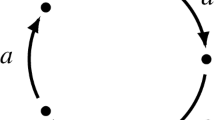Abstract
A celebrated result by Keller–Reiten says that 2-Calabi–Yau tilted algebras are Gorenstein and stably 3-Calabi–Yau. This note shows that the converse holds in the monomial case: a 1-Gorenstein monomial algebra and stably 3-Calabi–Yau is 2-Calabi–Yau tilted, moreover is Jacobian. We study the case of other stably Calabi–Yau Gorenstein monomial algebras.
Article PDF
Similar content being viewed by others
Avoid common mistakes on your manuscript.
References
Amiot, C.: Cluster categories for algebras of global dimension 2 and quivers with potential. Ann. Inst. Fourier 59(6), 2525–2590 (2009)
Amiot, C.: On generalized cluster categories, Representations of Algebras and Related Topics, EMS Ser. Congr. Rep. Eur. Math. Soc., Zürich, (16-02), pp. 1–53 (2011)
Assem, I., Brüstle, T., Charbonneau-Jodoin, G., Plamondon, P.G.: Gentle algebras arising from surface triangulations. Algebr. Number Theory 4(2), 201–229 (2010)
Assem, I., Simson, D., Skowroński, A.: Elements of the Representation Theory of Associative Algebras, London Math. Soc. Student Texts, vol. 65. Cambridge University Press (2006)
Baur, K., Marsh, R.: A geometric description of m-cluster categories. Trans. Amer. Math. Soc. 360(11), 5789–5803 (2008)
Beligiannis, A.: The homological theory of contravariantly finite subcategories: Auslander-buchweitz contexts Gorenstein categories and (co-)stabilization. Comm. Algebra 28(10), 4547–4596 (2000)
Beligiannis, A.: Relative homology, higher cluster-tilting theory and categorified Auslander-Iyama correspondence. J. Algebra 444, 367–503 (2015)
Burban, I., Iyama, O., Keller, B., Reiten, I.: Cluster tilting for one-dimensional hypersurface singularities. Adv. Math. 217(6), 2443–2484 (2008)
Buan, A., Marsh, R., Reineke, M., Reiten, I., Todorov, G.: Tilting theory and cluster combinatorics. Adv. Math. 204(2), 572–518 (2006)
Buan, A., Marsh, R., Reiten, I.: Cluster-tilted algebras. Trans. Amer. Math. Soc. 359(1), 323–332 (2007)
Butler, M. C. R., Ringel, C. M.: Auslander-reiten sequences with few middle terms and applications to string algebras. Commun. Algebra 15(1-2), 145–179 (1987)
Caldero, P., Chapoton, F., Schiffler, R.: Quivers with relations arising from clusters (an case). Trans. Amer. Math. Soc. 358(3), 1347–1364 (2006)
Chen, X. W., Shen, D., Zhou, G.: The Gorenstein-projective modules over a monomial algebra. Proc. R. Soc. Edinburgh Sect. Math. 148(6), 1115–1134 (2018)
Derksen, H., Weyman, J., Zelevinsky, A.: Quivers with potentials and their representations I: Mutations. Sel. Math. 14(1), 59–119 (2008)
Fomin, S., Zelevinsky, A.: Cluster algebras i: foundations. J. Am. Math. Soc. 15(2), 497–529 (2002)
Garcia Elsener, A., Schiffler, R.: On syzygies over 2-Calabi-Yau tilted algebras. J. Algebra 470, 91–121 (2017)
Geiss, Ch., Reiten, I.: Gentle Algebras are Gorenstein. Representations of algebras and related topics (45), 129 (2005)
Gubitosi, V.: M-cluster tilted algebras of type Ã. Comm. Algebra 46(8), 3563–3590 (2018)
Happel, D., Ringel, C. M.: Tilted algebras. Trans. Am. Math. Soc. 274(2), 399–443 (1982)
Kalck, M.: Singularity categories of gentle algebras. Bulle Lond Math Soc 47(1) (2014)
Keller, B., Reiten, I.: Cluster-tilted algebras are Gorenstein and stably Calabi–Yau. Adv. Math. 211(1), 123–151 (2007)
Keller, B., Reiten, I.: Acyclic Calabi-Yau categories. Compos. Math. 144(5), 1332–1348 (2008)
Ladkani, S.: 2-CY-tilted algebras that are not Jacobian. arXiv:1403.6814 (2014)
Ladkani, S.: Finite-dimensional algebras are (m > 2)-Calabi-Yau-tilted. arXiv:1603.09709 (2016)
Lu, M., Zhu, B.: Singularity categories of Gorenstein monomial algebras. arXiv:1708.00311 (2017)
Murphy, G. J.: Derived equivalence classification of m-cluster tilted algebras of type An. J. Algebra 323(4), 920–965 (2010)
Reiten, I.: Calabi-yau tilted algebras. Sao Paulo J. Math. Sci. 4(3), 529–545 (2010)
Thomas, H.: Defining an m-cluster category. J. Algebra 318(1), 37–46 (2007)
Torkildsen, H. A.: A Geometric Realization of the m-cluster Category of Affine Type A. Comm. Algebra 43(6), 2541–2567 (2015)
Auslander, M., Smalø, S.: Almost split sequences in subcategories. J. Algebra 2, 426–454 (1981)
Auslander, M., Reiten, I.: Cohen-macaulay and Gorenstein Artin algebras. Progr. Math. 95, 221–245 (1991)
Garcia Elsener, A., Schiffler, R.: On syzygies over 2-Calabi–Yau tilted algebras. J. Algebra 470, 91–121 (2017)
Kalck, M.: Singularity categories of gentle algebras. Bull. Lond. Math. Soc. 47(1), 65–74 (2015)
Acknowledgments
This work was supported by the Austrian Science Fund Project Number P25647- N26. The author wants to thank the researchers at Universität Stuttgart, especially Prof. Steffen Koenig and Dr. Matthew Pressland, and also would like to thank the organizers of BIREP-2017 Summer School on Gentle Algebras.
Funding
Open access funding provided by University of Graz.
Author information
Authors and Affiliations
Corresponding author
Additional information
Presented by: Steffen Koenig
Publisher’s Note
Springer Nature remains neutral with regard to jurisdictional claims in published maps and institutional affiliations.
Appendix A: Auslander–Reiten translations for Gorenstein algebras by Sondre Kvamme and Matthew Pressland
Appendix A: Auslander–Reiten translations for Gorenstein algebras by Sondre Kvamme and Matthew Pressland
Let Λ be an Iwanaga–Gorenstein algebra. Since GP(Λ) is a functorially finite subcategory of modΛ, it has Auslander–Reiten sequences [30], inducing an Auslander–Reiten translation τGP on \(\underline {GP}({\Lambda })\), typically different from the Auslander–Reiten translation τΛ on \(\underline {\textup {mod}}{\Lambda }\). The goal of this appendix is to relate the objects τΛM and τGPM of \(\underline {\textup {mod}}{\Lambda }\) when M is Gorenstein projective. Indeed, we will show that these objects eventually coincide after repeated application of the syzygy functor. While this fact may not be surprising to experts, and can be deduced quickly from results already in the literature (most easily from [31, Thm. 3.7]), we give here a very direct proof, which even exhibits a natural isomorphism of functors. Moreover, we explain how this result provides a new perspective on results of Garcia Elsener (Corollary 4.6 of the present paper) and Garcia Elsener–Schiffler [32, Thm. 1] characterising Gorenstein projective modules over certain Calabi–Yau tilted algebras Λ, by relating these characterisations directly to a Calabi–Yau property of \(\underline {GP}({\Lambda })\).
We denote by \({\Omega }\colon \underline {\textup {mod}}{\Lambda }\to \underline {\textup {mod}}{\Lambda }\) the syzygy functor, taking a module to the kernel of a projective cover, and by \({\Sigma }\colon \underline {\textup {mod}}{\Lambda }\to \underline {\textup {mod}}{\Lambda }\) its left adjoint, taking a module to the cokernel of a right projΛ-approximation. The restrictions of these functors to \(\underline {GP}({\Lambda })\) are mutually inverse, the restriction of Σ being the suspension functor on this triangulated category.
Lemma A.1
The functor \({\Sigma }^{d}\colon \underline {\textup {mod}}{\Lambda }\to \underline {\textup {mod}}{\Lambda }\) has essential image in \(\underline {GP}({\Lambda })\).
Proof
Since Λ is d-Iwanaga–Gorenstein, we have \({\Omega }^{d}{\Sigma }^{d}M\in \underline {GP}({\Lambda })\) for any Λ-module M. Then \({\Sigma }^{d}{\Omega }^{d}{\Sigma }^{d}M\in \underline {GP}({\Lambda })\) since Σ preserves Gorenstein projectivity. It follows from the triangular identities for the unit and counit of the adjoint pair (Σd,Ωd) that ΣdM is a summand of ΣdΩdΣdM, and hence is itself Gorenstein projective. □
Theorem A.2
Let Λ be a finite-dimensional Iwanaga–Gorenstein algebra of Gorenstein dimension at most d. Then there is a natural isomorphism
of endofunctors of \(\underline {GP}({\Lambda })\).
Proof
Using the Yoneda embedding, it suffices to show that there is a natural isomorphism
of functors on \(\underline {\textup {mod}}{\Lambda }\), for any X ∈GP(Λ). By adjunction and the Auslander–Reiten formula for GP(Λ), we obtain natural isomorphisms
The validity of the second isomorphism depends on Lemma A.1, showing that Σd takes values in \(\underline {GP}({\Lambda })\). Alternatively, using the Auslander–Reiten formula in modΛ, we get
The two right-hand sides coincide, completing the proof. □
Theorem A.3 ([32, Thm. 1])
Let Λ be a 2-Calabi–Yau tilted algebra. Then a Λ-module M is Gorenstein projective if and only if M≅Ω2τΛM in \(\underline {\textup {mod}}{\Lambda }\).
Proof
By a result of Keller and Reiten [21, Prop. 2.1], a 2-Calabi–Yau tilted algebra is Iwanaga–Gorenstein of Gorenstein dimension at most 1. Thus \({\Omega }^{2} N\in \underline {GP}({\Lambda })\) for any N ∈modΛ, and the ‘if’ part of the theorem follows immediately.
For the ‘only if’ direction, Keller and Reiten also prove [21, Thm. 3.3] that \(\underline {GP}({\Lambda })\) is a 3-Calabi–Yau category, meaning that Σ3 is a Serre functor. On the other hand, the Auslander–Reiten formula states that ΣτGP is always a Serre functor on \(\underline {GP}({\Lambda })\). Since Serre functors are unique up to natural isomorphism, the 3-Calabi–Yau property is equivalent to there being a natural isomorphism \(\tau _{\textup {GP}}\simeq {\Sigma }^{2}\). Now by Theorem A.2, using again the Iwanaga–Gorenstein property of Λ, we have
□
We close by observing that characterisations of Gorenstein projective Λ-modules as in Theorem A.3 are closely related to Calabi–Yau properties of \(\underline {GP}({\Lambda })\) in wider generality.
Proposition A.4
Let Λ be Iwanaga–Gorenstein of Gorenstein dimension at most m. Then \(\underline {GP}({\Lambda })\) is (m + 1)-Calabi–Yau if and only if there is a natural isomorphism \({\Omega }^{m}\tau _{\Lambda }\simeq \text {Id}_{\underline {GP}({\Lambda })}\). In this case, a Λ-module M is Gorenstein projective if and only if M≅ΩmτΛM in \(\underline {\textup {mod}}{\Lambda }\).
Proof
As in the proof of Theorem A.2, \(\underline {GP}({\Lambda })\) is (m + 1)-Calabi–Yau if and only if there is a natural isomorphism \(\tau _{\textup {GP}}\simeq {\Sigma }^{m}\) on \(\underline {GP}({\Lambda })\). Since Σm has quasi-inverse Ωm on this category, this is equivalent to asking that \({\Omega }^{m}\tau _{\textup {GP}}\simeq \text {Id}_{\underline {GP}({\Lambda })}\). But Theorem A.2 tells us that \({\Omega }^{m}\tau _{\textup {GP}}\simeq {\Omega }^{m}\tau _{\Lambda }\) in this setting, and the first part of the statement follows. The second part is then proved as in Theorem A.3, replacing 2 by m. □
Note that the isomorphisms constructed in the proof of Theorem A.3 arise from a natural isomorphism in this way, using the 3-Calabi–Yau property of \(\underline {GP}({\Lambda })\) [21, Thm. 3.3]. We also deduce that a similar Calabi–Yau property holds for certain gentle m-cluster-tilted algebras.
Corollary A.5
Let Λ be an m-cluster-tilted algebra of type \(\mathbb {A}\) or \(\tilde {\mathbb {A}}\). Then \(\underline {GP}({\Lambda })\) is (m + 1)-Calabi–Yau.
Proof
By Corollary 4.6, Λ is Iwanaga–Gorenstein of Gorenstein dimension at most m, and M≅ΩmτΛM for each M ∈GP(Λ). Since Λ is a gentle algebra, meaning that \(\underline {GP}({\Lambda })\) is semi-simple [33], there must be a collection of such isomorphisms that is natural in M—for example, by first choosing such an isomorphism for each M in a set of representatives for the isoclasses of indecomposable objects, and then extending to arbitrary objects by choosing direct sum decompositions. (We use here that the ground field k is algebraically closed, so that each indecomposable has endomorphism ring k.) The result then follows by Proposition A.4. □
Rights and permissions
Open Access This article is licensed under a Creative Commons Attribution 4.0 International License, which permits use, sharing, adaptation, distribution and reproduction in any medium or format, as long as you give appropriate credit to the original author(s) and the source, provide a link to the Creative Commons licence, and indicate if changes were made. The images or other third party material in this article are included in the article's Creative Commons licence, unless indicated otherwise in a credit line to the material. If material is not included in the article's Creative Commons licence and your intended use is not permitted by statutory regulation or exceeds the permitted use, you will need to obtain permission directly from the copyright holder. To view a copy of this licence, visit http://creativecommons.org/licenses/by/4.0/.
About this article
Cite this article
Elsener, A.G. Monomial Gorenstein algebras and the stably Calabi–Yau property. Algebr Represent Theor 24, 1083–1099 (2021). https://doi.org/10.1007/s10468-020-09980-y
Received:
Accepted:
Published:
Issue Date:
DOI: https://doi.org/10.1007/s10468-020-09980-y




